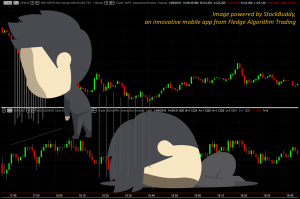“Hey, David! You did so many trading strategies for retail traders from all walks of life.
Which type is the most profitable? Is it moving average, RSI, MACD or Elliot Wave?” Day traders always ask me these questions in seminars.
 My response is simple, “None! We tested the most commonly used indicators, with standard parameters, in E-mini S&P 500 futures (ES), EUR-USD and Hong Kong Hang Seng Futures. All of them are losers!”
My response is simple, “None! We tested the most commonly used indicators, with standard parameters, in E-mini S&P 500 futures (ES), EUR-USD and Hong Kong Hang Seng Futures. All of them are losers!”
The next question usually follows, “What’s your suggestion, then?” I reply, “Build your own!”
In the article, I’ll share with you six steps to build your own proprietary trading strategies.
- Observation: Print the hardcopy of a 1-min chart of the previous You’ll have around 200 papers. Stick them on your walls. In this way you may discover some commonly appearing patterns with the naked eye. We found “Friday Effect in Hang Seng Futures” through this exercise.
- Standardisation: To build a prototype, you have to add some essential elements into your idea, the entry and exit rules. Under what circumstances will you buy or sell? What is your target profit and stop loss? Brainstorm all possible scenarios, no matter how frequently they’ll appear. Draw a flowchart to confirm what you have.

- Examination: Intuition is important, but beware of bias or preconceptions. If the latest price crosses over the moving average of 200 bars, is it a bullish signal? Maybe, or maybe not. A scientific way of proving is backtesting your trading strategies with historical data. MultiCharts is definitely the best of breed on the market. You can base it on your flowchart and “translate” it to PowerLanguage quickly and precisely.
- Analysis: Read the backtest performance report and you’ll know how good (or how bad) your trading strategy was. Profit factor, maximum drawdown and equity curve are definitely the most important figures. If the result is not satisfactory, repeat step one. You lose nothing except time. Never attempt to trade with an over-optimized strategy.
- Simulation: Always apply for a simulation account before real trades. There are some lethal factors that you may not be aware of when you’re doing backtesting, e.g. commission, slippage and “touch-but-not-filled” issue. No matter whether you’re using a market order, stop order or limit order, slippages are always higher than most traders imagine. You may need a longer time to polish your strategy if your trading frequency is as high as one round-trade in a few minutes.
- Real trade: The financial markets (some gamblers like calling them a “casino”) are always there. There’s no need to rush into the market. Start with small capital and grow big by “capital management”, or “position sizing” as it is also called. Our squad’s initial capital could be as small as US$5000. See this video for details: http://www.fledgetrade.com/EN/Index-Animation.html
Trading is simple but not easy. There’s no shortcut to becoming rich. Some traders lose everything (even bankruptcy and family breakups) before they can discover a profitable strategy. They comfort themselves by considering money lost as a “tutorial fee”. But that’s not necessary. Always use MultiCharts to prove before you trade. You can learn some valuable lessons and gain some meaningful experience during the above development steps without losing a penny. Don’t start real, big trading until you pass all five of the steps above. Good luck!
Written by
David.Wong@FledgeTrade.com
